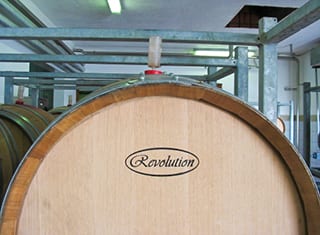Ellagitannins are hydrolysable tannins, which do not occur naturally in grapes. It is however the tannins, which are mostly allowed as legal additives during winemaking. The ellagitannins, which occur in wine are extracted from wooden barrels or added as legal enological tannins to wine. Ellagitannins play an important role in the maturation of white and red wine in barrels, as result of its oxidation ability and flavour characteristics.
During the maturation of wine in barrels a constant oxygen migration occurs through the barrel pores and the ellagitannins present in the wood dissolve gradually in the wine. This creates an effective buffer against the potential oxidation of the wine, during barrel maturation. The ellagitannins, whether it originates from the barrels, alternative wood products or added enological tannins are readily oxidised. It is a catalytic chemical reaction, known as peroxidation. Any oxygen exposed to the wine will react with ellagitannins and temper the direct oxidation of other wine constituents. Ellagitannins will consequently promote the crimson colour of red wine and limit the formation of a brown brick colour. Ellagitannins also decrease the astringency and colour deposits of red wines (Vivas et al., 1996).
Limited data is known about the influence of ellagitannins on the oxidative stability of white wines. Oxidative instability was first observed during the early 1990’s where after winemakers acted precautionary to prevent early maturation. Icon white wines have irrespective of its sensory quality also a significant shelf life. The management of barrel maturation plays a decisive role in the making of premium white wines. Except for the role in micro oxygenation and the increase in phenolic and flavour compounds oak wood does also play an important role in the oxidative status of white wines. It influences the redox potential and consequently the oxidative stability of wine. The anti-oxidative capacity of oak wood depends on its ellagitannin concentration. Early research indicated that the ellagitannin concentration increases rapidly during the first three months of barrel maturation. Different physic-chemical factors declare its subsequent decrease in concentration. The high reactivity of ellagitannins towards oxygen is one of these reasons.
Research was done at the University of Burgundy to obtain more data about the stabilising capacity of compounds extracted from wood, especially about the oxidation of white wines. The first step was to differentiate between wine which was matured in barrels with different toasting levels and tannin potential. Molecular analyses were also executed on ellagitannins, grape phenolic compounds and glutathione to identify the wood compounds, which influence the oxidative stability of wines. Chardonnay, Sauvignon blanc and Semillon wines from 2015 and 2016 were investigated over a period of eight months barrel maturation.
The following conclusions were made after all the experiments:
● Barrel maturation improves the oxidative stability of white wines.
● A positive correlation exists between the tannin potential of barrels and the oxidative stability of wines.
● Different toasting levels do not have an effect on the oxidative stability of wines.
● A positive correlation exists between the tannin potential of the barrel and the ellagitannin concentration in the wines.
● As confirmed previously a considerable increase in the ellagitannin concentration of wine occurs during the first three months of barrel maturation.
● The duration of barrel maturation required to obtain the maximum ellagitannin concentration in wine is rather determined by the composition of the wine than the tannin potential of the barrels. Factors like pH, alcohol concentration and temperature can influence the rate of ellagitannin extraction from the wood.
● The evolution of the known anti-oxidant, glutathione, according to the tannin potential of the wood was also monitored. During barrel maturation the glutathione concentration of the wine decreased progressively, depending on the barrel and the wine (Nikolantonaki et al., 2018).


Ellagitannins can be extracted from barrels and alternative wood products.
References
Nikolantonaki, M., Coelho, C., Diaz-Rubio, M-E., Rozier, J., Haroun, C., Zbirko, A., Gougeon, R., Badet-Murat, M-L. & Vicard, J-C. 2018. Impact of oak tannin and barrel toasting on the oxidative stability of dry white wine. Australian and New Zealand Grapegrower and Winemaker, August 2018: 63 – 68.
Vivas, N. & Glores, Y., 1996. Research note: Role of wood ellagitannins in the oxidation process of red wines during aging. American Journal of Enology and Viticulture 47(1): 103 – 107.













